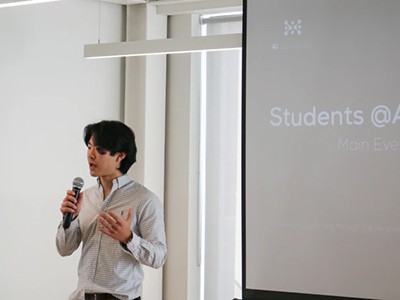ChatGPT and the Future of AI: The Deep Language Revolution Terrence J. Sejnowski The MIT Press (2024)
Some of the surprise winners of this year’s Nobel prizes were the developers of AlphaFold, an artificial intelligence (AI) model that can accurately predict the 3D structure of more than 200 million proteins. AlphaFold is powered by artificial neural networks that can glean patterns from how amino acids interact in known proteins and then use that information to model the behaviour of unknown proteins. Chatbots such as ChatGPT rely on similar technology to ‘learn’ and mimic human language.
The revolution set in motion by this technology is compellingly explored in Terrence Sejnowski’s ChatGPT and the Future of AI — a sequel to his 2018 book The Deep Learning Revolution. Sejnowski, a computational neurobiologist, takes readers on a whirlwind tour of the evolution of AI — from simple computational models of a single neuron built in the 1950s to breakthroughs in deep learning over the past two decades that have resulted in the birth of large language models (LLMs), which can generate human-like responses to questions.
ChatGPT one year on: who is using it, how and why?
Sejnowski’s book is a must-read for those seeking to understand the world we live in — a world in which machines transform the fabric of human cognition. Put simply, a neural network is a web of interconnected nodes, or neurons, that can process data and learn from them by adjusting the strength of the connections between the nodes. When the strength of these connections is altered to achieve a desired output during a training phase, the model learns to detect underlying patterns.
The fundamental inspiration behind neural-network architectures is the human brain. Sejnowski suggests that untangling the mystery of why these simulated models of the brain work so well — especially when they are trained on large amounts of data — could prove to be as seminal as the discovery of DNA. By rigorously interrogating the “otherworldly behaviour” of LLMs, new conceptual frameworks might emerge, he predicts.
He sees parallels between the current debates over the meanings of ‘intelligence’ and ‘understanding’ and discussions a century ago about the nature of life. Back then, vitalists argued that life is a non-physical force — an essence infused in living things but not in, say, rocks — whereas mechanists thought that life could be fully explained by physical and chemical processes. Just as the discovery of the DNA double helix bridged conceptual gaps and transformed biology, Sejnowski predicts that advances in AI will bring forth revelations about intelligence.
Evolving understanding
The holy grail of AI, Sejnowski explains, is artificial general intelligence: a machine that can think, learn and solve problems across a wide range of tasks, much like a human can. The current generation of LLMs is far from that. Referred to pejoratively by some researchers as ‘stochastic parrots’, they mostly mimic human language without true comprehension.
Ready or not, AI is coming to science education — and students have opinions
The road ahead for AI is one of interdisciplinary collaboration, Sejnowski argues, in which insights from biology, neuroscience and computer science converge to guide AI development. Sejnowski imagines that insights about the “fundamental principles of intelligence” — such as adaptability, flexibility and the ability to make general inferences from limited information — will catalyse the next generation of machine intelligence.
The AI language revolution, which is how Sejnowski refers to the era of LLMs, is already reshaping many aspects of human life. As LLMs evolve, they will surpass their primary role as tools and start acting as collaborators in domains such as health care, education and law. That’s already beginning to happen, as shown by AlphaFold. The author liberally uses ChatGPT to provide summaries at the end of each chapter, and conversations with the chatbot are littered throughout the book. He even playfully acknowledges ChatGPT as a co-author.
The power of LLMs also lies in how users interact with them. Sejnowski flags the increasingly important skill of prompt engineering, which stresses that subtle changes in how you instruct a model can shape its output. The author offers helpful hacks: ask for multiple responses, not just one; be specific, so that the model can converge on the best answer quickly; shape your dialogue as if you are talking with a real person.
Sejnowski proposes a “reverse Turing test”, in which the intelligence of the prompter is assessed on the basis of the quality of their interactions with the AI. Such proficiency tests might become common as AI use spreads.
Can AI have common sense? Finding out will be key to achieving machine intelligence
The next generation of LLMs must undergo a developmental process akin to the childhood learning phase in humans, he surmises, learning from real-world interactions as well as data. Long-term memory and goal-oriented behaviour must be integrated so that systems can adapt and plan effectively. The addition of robotics and sensorimotor systems would allow AI tools to perceive and interact with their environment, nudging current models towards artificial general autonomy.
Although Sejnowski is optimistic about the technology, he acknowledges that there are many unsolved challenges that will need to be addressed to ensure the long-term sustainability of AI. It is likely to disrupt industries and the job market. And, the increasing necessity for heavy computational processing power has brought to the forefront the need for more-efficient, greener AI models.
Although it is some way off, it is also important, Sejnowski writes, to seriously examine the possibility of AI exceeding human intelligence, because preparing now will allow us to anticipate and mitigate potential threats. A careful and well-regulated strategy to manage ethical and existential risks — such as of AI-induced errors and political weaponization of LLMs — is essential to ensure that AI benefits society.
ChatGPT and the Future of AI sets out how the next wave of AI-driven breakthroughs could alter the landscape of knowledge itself. Sejnowski’s exploration serves as both a guide and a warning as we navigate the promises and perils of AI’s rapid advancement.
Competing Interests
The author declares no competing interests.





